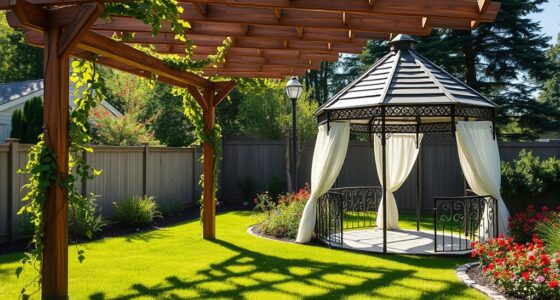Smart irrigation systems do save water by adjusting watering times based on weather, soil moisture, and plant needs. You can typically expect reductions of 15% to 40%, with some systems reaching up to 70% savings with proper setup. Features like weather-based controllers and soil moisture sensors are especially effective. These systems also cut energy costs and prevent costly leaks. Keep exploring to discover how to maximize your water savings and improve your landscape’s efficiency.
Key Takeaways
- Smart irrigation systems can save approximately 15% to over 50% of water, depending on setup and environmental factors.
- Weather-based controllers and soil moisture sensors are highly effective in optimizing water use.
- Proper installation, calibration, and maintenance are essential to achieve maximum water savings.
- These systems also reduce energy costs and prevent costly leaks, amplifying overall efficiency.
- Widespread adoption across residential and commercial sectors significantly contributes to water conservation efforts.

Smart irrigation systems are transforming the way we water our landscapes by using advanced technology to optimize water use and reduce waste. These systems leverage sensors, weather data, and automation to deliver the right amount of water at the right time, preventing overwatering and conserving resources. Controlled studies show that, under ideal conditions, smart systems can save around 50% of water, with typical savings in residential and commercial landscapes ranging from 15% to 40%. The actual savings depend on factors like climate, plant type, sensor quality, and how well the system is installed and maintained. When set up correctly and fine-tuned, savings can reach between 40% and 70%, but without proper calibration, most users see closer to 10% reduction. In agricultural settings, water savings vary from 10% to 40%, mainly influenced by crop type and environmental conditions. Residential systems, especially those with smart controllers, often cut outdoor water use by 20% to 50%, while commercial landscapes can save up to 60%. These numbers highlight how effective smart irrigation can be across different sectors.
Smart irrigation can save 10% to 70% of water across residential, commercial, and agricultural landscapes through advanced sensors and automation.
The technology behind these systems includes weather-based controllers, soil moisture sensors, rain sensors, and integrations with building automation systems. Weather-based controllers automatically adjust watering schedules based on local weather data, making them easy to retrofit and proven to deliver consistent savings. Soil moisture sensors, especially when paired with rain sensors, provide the highest water savings—over 60% in some cases—by directly measuring soil conditions and preventing unnecessary watering. Wifi-enabled controllers add remote control and weather alerts, giving you more flexibility and oversight. Rain sensors alone can reduce water use by around 22%, but soil moisture sensors are more effective overall. Some advanced systems even connect to building automation systems, achieving up to 66% water savings in experimental settings. These systems utilize data-driven algorithms to optimize watering schedules, further enhancing efficiency. Using smart irrigation also cuts energy costs by up to 30%, since more precise watering reduces the need for water pumping and system run times. This efficiency not only conserves resources but also lowers your utility bills, with ROI rates of 87% for rain sensors and 200% for soil moisture sensors within the first year. Preventing leaks with smart detection features further saves money by avoiding costly turf damage, which can reach $4.50 per square foot to repair. Proper system setup, ongoing maintenance, and user education are critical for maximizing savings. If you program and maintain your system correctly, you can markedly reduce water waste, especially if your baseline usage is high. Additionally, advanced sensor technology is continually improving accuracy and reliability, making smart irrigation systems more effective than ever. Conversely, poor setup or complex underground modifications can hinder sensor adoption, making weather-based systems more practical for many users.
Across sectors, smart irrigation proves its worth. Residential properties see savings of 20% to 50%, while commercial landscapes like parks, schools, and golf courses often save even more. By adopting these systems, you not only conserve water but also reduce energy consumption and costs, making your landscape more sustainable and financially efficient.
Frequently Asked Questions
How Much Can I Expect to Save Annually With Smart Irrigation?
You can expect to save a significant amount of water annually with smart irrigation. Depending on your system and location, savings can range from about 16% to over 50%. For example, Southern California homeowners report up to 50% savings, while agricultural users could save billions of gallons each year. Combining rain and soil moisture sensors can boost savings even further, making your investment both eco-friendly and cost-effective.
Are Smart Irrigation Systems Suitable for Small or Urban Gardens?
Think of your small or urban garden as a delicate dance floor, where every step counts. Smart irrigation systems fit perfectly, adjusting watering precisely to your garden’s needs. They’re easy to install, connect wirelessly, and can be managed remotely. Whether it’s a balcony, rooftop, or community plot, these systems adapt to diverse plant types and conditions, making them a smart, water-saving partner for your urban gardening efforts.
What Are the Maintenance Requirements for These Systems?
You need to regularly check and maintain your smart irrigation system to guarantee it runs efficiently. This includes inspecting for leaks, cleaning nozzles, and adjusting sprinkler angles seasonally. You should also update system settings based on weather, install sensors, and schedule professional audits annually. Proper winterization and replacing worn parts help prevent damage. Keeping your system well-maintained maximizes water savings and prolongs its lifespan.
Can Smart Irrigation Be Integrated With Existing Smart Home Devices?
You can easily integrate smart irrigation with your existing smart home devices. Most controllers connect via Wi-Fi or other protocols like Zigbee or Z-Wave, allowing remote control through apps or voice commands with platforms like Alexa, Google Assistant, or Apple HomeKit. With proper setup, you can automate watering schedules based on weather or soil data, giving you convenience, better resource management, and seamless control alongside your lighting, HVAC, and other smart home systems.
Are There Any Environmental or Soil Conditions That Affect System Performance?
Environmental and soil conditions considerably influence your smart irrigation system’s performance. Variability in rainfall, wind, temperature, and solar radiation can cause over- or under-watering if sensors aren’t properly calibrated. Soil texture, moisture, compaction, and organic matter affect water absorption and retention, impacting system accuracy. Additionally, plant types, root depth, and landscape layout require adjustments to guarantee efficient watering. Keeping these factors in check helps your system operate at its best and conserve water.
Conclusion
Imagine your garden as a thirsty soul, longing for just the right sip of water. With smart irrigation systems, you become its gentle rainmaker, guiding each droplet with precision and care. They don’t just save water; they nurture your landscape like a loving gardener tending to every leaf and root. So, embrace these intelligent systems and transform your yard into a lush, thriving oasis—where every drop counts and nature’s beauty blooms in harmony.









